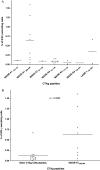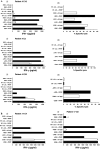Dominant responses with conservation of T-cell receptor usage in the CD8+ T-cell recognition of a cancer testis antigen peptide presented through HLA-Cw7 in patients with multiple myeloma
- PMID: 21785964
- PMCID: PMC11028534
- DOI: 10.1007/s00262-011-1070-y
Dominant responses with conservation of T-cell receptor usage in the CD8+ T-cell recognition of a cancer testis antigen peptide presented through HLA-Cw7 in patients with multiple myeloma
Abstract
Cancer testis antigens exhibit physiological expression within germ cells and are frequently expressed in malignant tissue. Interestingly, immunological tolerance to cancer testis proteins does not appear to be established, and the expression of CTAg proteins within malignant cells can therefore lead to induction of cellular and humoral immunity. A considerable body of evidence now indicates that CD8-specific immunity plays an important role in the control of cancer cell growth, and a number of vaccine studies are in progress to boost CTAg-specific cellular immune responses. We have previously identified CTAg-specific immune responses in patients with multiple myeloma and reported that recognition of the MAGE-A1(289-298) peptide, which is described as being restricted by HLA-B*0702, was the most frequent response seen with our peptide panel. Here, we studied seven CD8+ T-cell clones specific for this peptide which were isolated from three patients with myeloma at several time-points. The affinity of peptide recognition was high with 50% maximal interferon-γ production observed at a peptide concentration of 10(-10) M and variation of only one order of magnitude between the affinities of the clones. Importantly, all the clones were able to recognise and kill multiple myeloma cell lines. Interestingly, one patient did not express HLA-B*0702, but three clones from this patient recognised the MAGE-A1(289-298) peptide on a lymphoblastoid cell line (LCLs) expressing HLA-Cw7, and we now show evidence that the MAGE-A1(289-298) peptide is expressed and recognised through Cw7. The T-cell receptor gene usage was determined in five clones and showed conserved features in both the α and the β chain genes indicating correlation between T-cell receptor usage and peptide specificity of cancer testis antigen-specific T-cell clones.
Conflict of interest statement
The author declares no competing financial interests.
Figures




Similar articles
-
Lack of tumor recognition by cytolytic T lymphocyte clones recognizing peptide 195-203 encoded by gene MAGE-A3 and presented by HLA-A24 molecules.Cancer Immunol Immunother. 2007 Feb;56(2):259-69. doi: 10.1007/s00262-006-0186-y. Epub 2006 Jun 7. Cancer Immunol Immunother. 2007. PMID: 16758204 Free PMC article.
-
Dickkopf-1 (DKK1) is a widely expressed and potent tumor-associated antigen in multiple myeloma.Blood. 2007 Sep 1;110(5):1587-94. doi: 10.1182/blood-2007-03-082529. Epub 2007 May 21. Blood. 2007. PMID: 17515399 Free PMC article. Clinical Trial.
-
Identification of a naturally processed NY-ESO-1 peptide recognized by CD8+ T cells in the context of HLA-B51.Cancer Immun. 2002 Sep 19;2:12. Cancer Immun. 2002. PMID: 12747757
-
Development of a T cell receptor targeting an HLA-A*0201 restricted epitope from the cancer-testis antigen SSX2 for adoptive immunotherapy of cancer.PLoS One. 2014 Mar 28;9(3):e93321. doi: 10.1371/journal.pone.0093321. eCollection 2014. PLoS One. 2014. PMID: 24681846 Free PMC article.
-
Polyspecificity of T cell and B cell receptor recognition.Semin Immunol. 2007 Aug;19(4):216-24. doi: 10.1016/j.smim.2007.02.012. Epub 2007 Mar 29. Semin Immunol. 2007. PMID: 17398114 Free PMC article. Review.
Cited by
-
Therapeutic Cancer Vaccines-Antigen Discovery and Adjuvant Delivery Platforms.Pharmaceutics. 2022 Jul 11;14(7):1448. doi: 10.3390/pharmaceutics14071448. Pharmaceutics. 2022. PMID: 35890342 Free PMC article. Review.
-
Cancer testis antigens as immunogenic and oncogenic targets in breast cancer.Immunotherapy. 2018 Jul;10(9):769-778. doi: 10.2217/imt-2017-0179. Epub 2018 Jun 21. Immunotherapy. 2018. PMID: 29926750 Free PMC article. Review.
-
Dendritic Cell-Based Cancer Immunotherapy against Multiple Myeloma: From Bench to Clinic.Chonnam Med J. 2015 Apr;51(1):1-7. doi: 10.4068/cmj.2015.51.1.1. Epub 2015 Apr 14. Chonnam Med J. 2015. PMID: 25914874 Free PMC article. Review.
-
Differences in the frequencies of HLA-class I and II alleles between German patients with renal cell carcinoma and healthy controls.Cancer Immunol Immunother. 2017 May;66(5):565-571. doi: 10.1007/s00262-017-1957-3. Epub 2017 Feb 9. Cancer Immunol Immunother. 2017. PMID: 28184970 Free PMC article.
-
Database of T cell-defined human tumor antigens: the 2013 update.Cancer Immun. 2013 Jul 15;13:15. Print 2013. Cancer Immun. 2013. PMID: 23882160 Free PMC article. Review.
References
-
- van Rhee F, Szmania SM, Zhan F, Gupta SK, Pomtree M, Lin P, Batchu RB, Moreno A, Spagnoli G, Shaughnessy J, Tricot G. NY-ESO-1 is highly expressed in poor-prognosis multiple myeloma and induces spontaneous humoral and cellular immune responses. Blood. 2005;105(10):3939–3944. doi: 10.1182/blood-2004-09-3707. - DOI - PMC - PubMed
-
- Goodyear O, Piper K, Khan N, Starczynski J, Mahendra P, Pratt G, Moss P. CD8+ T cells specific for cancer germline gene antigens are found in many patients with multiple myeloma, and their frequency correlates with disease burden. Blood. 2005;106(13):4217–4224. doi: 10.1182/blood-2005-02-0563. - DOI - PubMed
Publication types
MeSH terms
Substances
Grants and funding
LinkOut - more resources
Full Text Sources
Other Literature Sources
Medical
Research Materials

